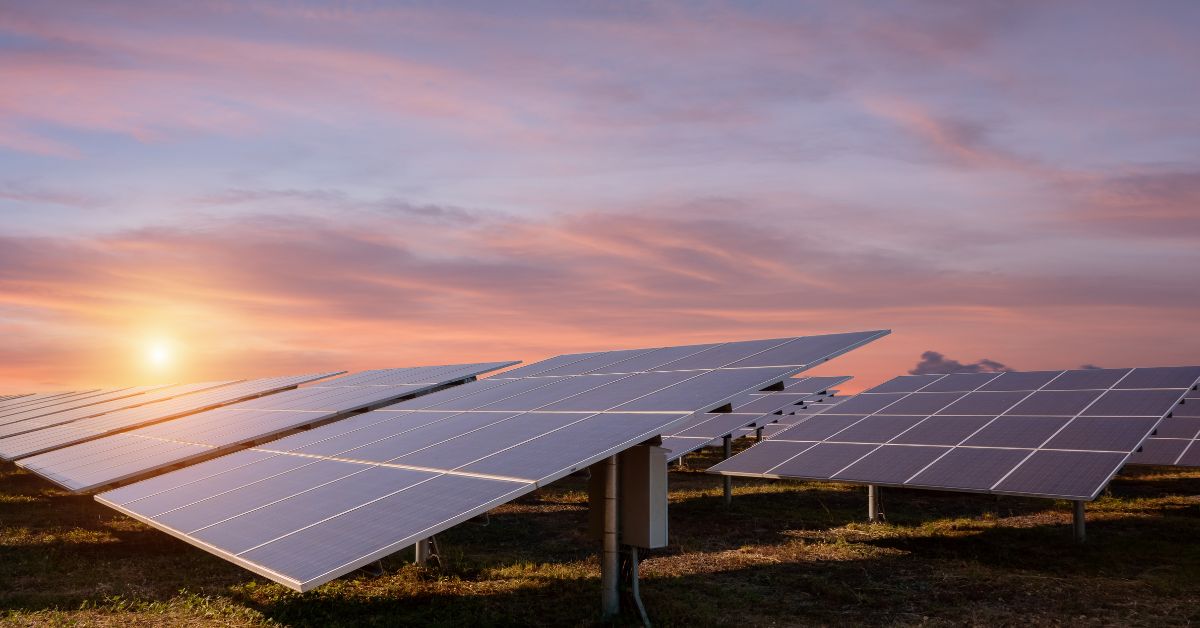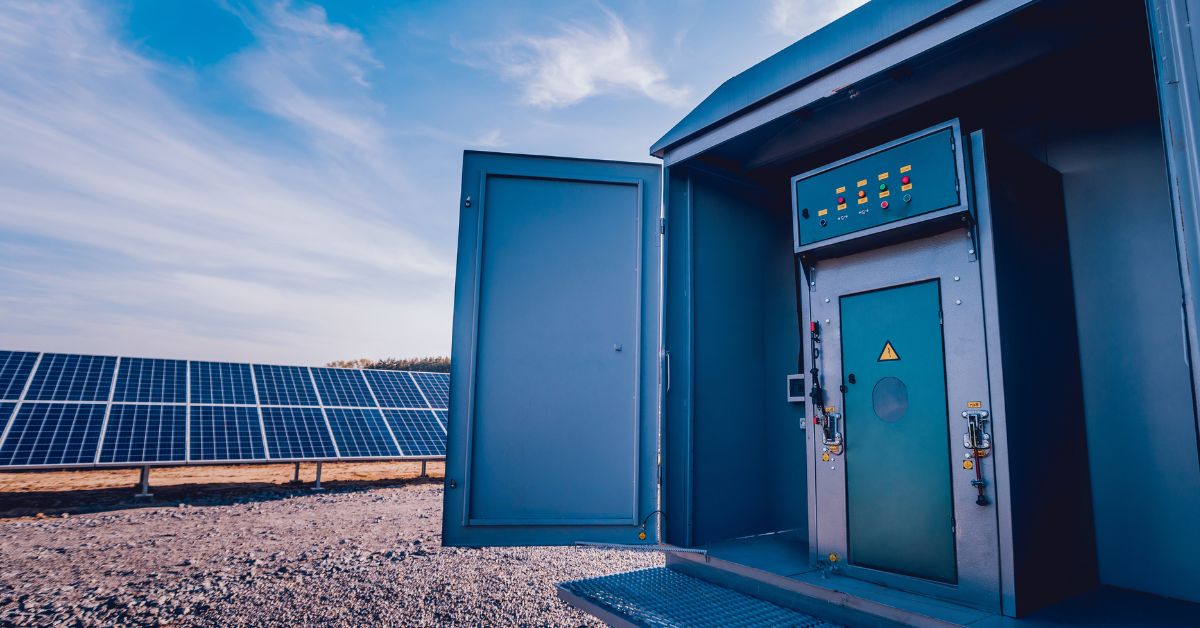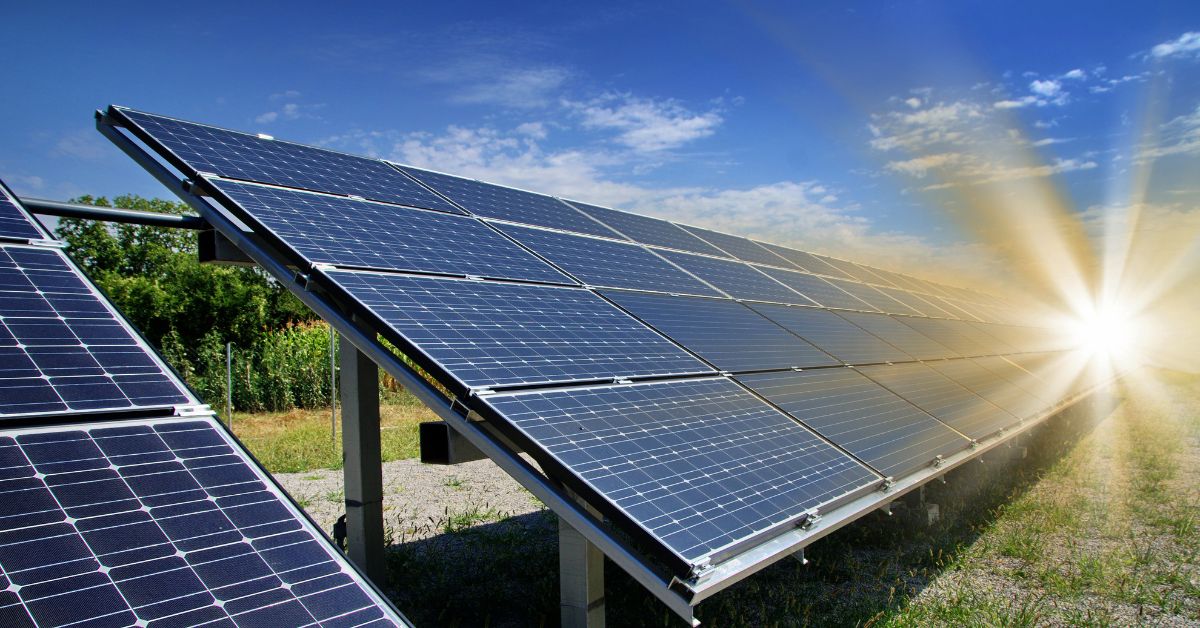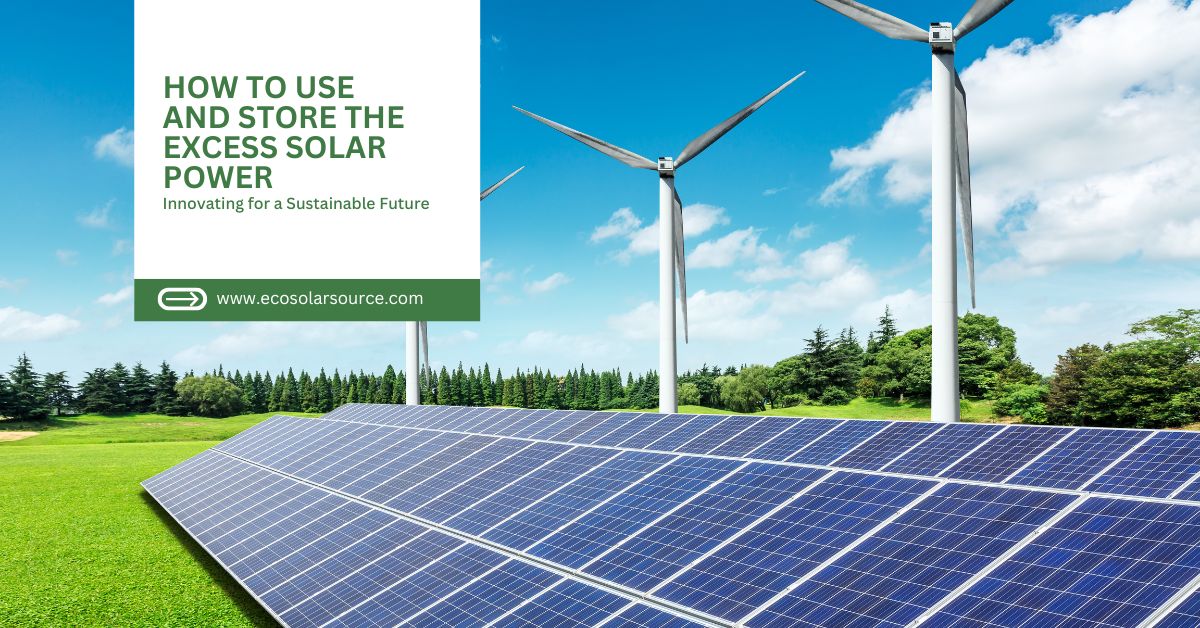How to Use and Store The Excess Solar Power
Know the details about How to Use and Store The Excess Solar Power, Maximizing excess solar power can make your system more efficient and sustainable. First, battery storage should be considered to save surplus energy for nighttime or cloudy days, allowing continuous power use. Alternatively, feed extra energy back to the grid if local net metering policies allow, potentially lowering your utility bills. Another option is to power high-energy devices, like water heaters or electric vehicles, during peak sunlight hours, making direct use of excess power. Additionally, smart home systems can help automate power use based on solar production, maximizing savings. By storing or redirecting excess power, you can optimize your solar setup’s efficiency.
Table of Contents
How to Use and Store Excess Solar Power
In the pursuit of a sustainable future, solar power has emerged as one of the most accessible and reliable sources of renewable energy. The increasing adoption of solar panels across residential and commercial spaces is evidence of their benefits, which include reducing electricity bills, lowering carbon footprints, and contributing to a cleaner environment. However, one of the challenges that come with solar energy is dealing with excess energy production—what to do with the surplus solar power that is generated, especially during sunny periods when the energy demand is low.
If you have a solar power system installed, you may find yourself in a situation where your panels produce more energy than you consume. Rather than letting this energy go to waste, several innovative and practical ways exist to use or store the excess solar power for later use. This comprehensive guide explores various methods for utilizing and storing excess solar power, ensuring that none of it goes to waste and providing solutions that maximize your investment in solar technology.
Understanding the Basics of Solar Energy Generation
Before diving into the methods of using and storing excess solar power, it is essential to understand how solar energy systems work. A typical solar power system consists of solar panels, an inverter, and a meter that measures the energy produced and consumed.

Solar panels convert sunlight into direct current (DC) electricity. The inverter then converts this DC electricity into alternating current (AC), which is the form of electricity most homes and appliances use. The electricity generated is used to power your home or business. If your solar panels produce more energy than you need, the excess electricity is either sent back to the grid (if you are connected to one) or stored in a battery (if you have one installed).
However, sending excess electricity back to the grid may not always be beneficial, depending on your local energy policies, as you may not get compensated for the full value of the energy produced. That’s why exploring alternative uses and storage methods can be a game-changer.
Using Excess Solar Power Efficiently
A. Power Your Home Appliances
The simplest way to make use of excess solar energy is to power your home appliances when the solar panels are producing more electricity than needed. Shifting energy-intensive activities like laundry, dishwashing, and cooking to the middle of the day—when solar production is typically at its peak—allows you to use more of your self-generated electricity. Here are a few ideas on how to manage this:
- Schedule Appliances: Many modern appliances like washing machines, dishwashers, and dryers come with programmable timers. By setting these appliances to run during peak solar production times, you maximize the use of solar energy.
- Smart Home Systems: Integrating a smart home system that can automatically control when appliances are running based on solar energy production can help you optimize energy usage. Smart home technology can connect to your solar system and manage appliances based on energy availability, making it easier to consume excess power without any manual intervention.
B. Heat Water with Solar Power
Another effective way to use surplus energy is to heat water. Solar water heating systems or conventional water heaters powered by electricity can use the excess energy produced during the day. Water heating typically consumes a significant amount of electricity, so you can reduce your reliance on grid electricity by using solar power for this purpose.
- Electric Water Heater: If you have an electric water heater, you can set it to operate during times of peak solar generation. This way, you’ll ensure your water is heated using solar energy, reducing the load on your grid power usage.
- Thermal Storage Systems: Some homes use thermal storage systems, which store heated water for later use. These systems can be integrated with your solar panels to ensure that any excess energy goes toward heating and storing hot water for use in the evening or the next day.
C. Charge Electric Vehicles (EVs)
As electric vehicles (EVs) become more popular, they represent a significant opportunity to use excess solar power. If you own an electric vehicle, charging it during the daytime when your solar panels are generating more electricity than you need can help offset the costs associated with running your EV. Here are two ways to do this effectively:
- Direct Charging: Plug your EV into a charging station at home during the day. Many electric vehicle chargers allow you to program charging times, ensuring that your vehicle charges when solar power is available. This method also helps reduce your dependence on grid power.
- Smart EV Charging: Some advanced solar systems offer smart EV charging, which automatically optimizes charging times to align with solar production. This method maximizes the amount of solar energy used to charge your vehicle, reducing costs even further.
D. Run Energy-Intensive Systems
Some homes have energy-intensive systems that can be scheduled to run during periods of excess solar energy production. These could include:
- Pool Pumps: Swimming pools require energy for filtration, heating, and cleaning systems. By operating these systems during sunny days when excess solar power is available, you can significantly reduce your electricity bill.
- Irrigation Systems: If you have an extensive garden or lawn that requires irrigation, using solar-powered pumps during the day can be an efficient way to manage excess energy.
Storing Excess Solar Power
When you’re not able to use all the solar power your system generates during the day, storing it for later use is an ideal solution. There are several ways to store solar energy effectively, ensuring that none of it is wasted and that you have access to energy when the sun isn’t shining, such as at night or during cloudy weather.

A. Battery Storage
Battery storage is one of the most popular and effective ways to store excess solar power for future use. Batteries store electricity generated by your solar panels and can discharge it when needed, allowing you to use solar energy even when your system isn’t producing power.
- Lithium-Ion Batteries: These are the most common type of the batteries used in residential solar systems. They are compact, efficient, and offer long lifespans, making them an ideal choice for storing excess solar energy.
- Deep Cycle Batteries: Deep cycle batteries, including lead-acid and newer variations such as lithium iron phosphate (LiFePO4), are designed to be discharged and recharged many times. These batteries are a reliable option for storing solar power, although they tend to be larger and less efficient than lithium-ion batteries.
Benefits of Battery Storage:
- Energy Independence: Having a battery storage system means you can use your own energy even when the sun isn’t shining. This provides greater energy independence, especially if you live in an area with frequent power outages.
- Lower Energy Bills: By using stored energy during peak demand periods (when grid electricity is typically more expensive), you can significantly lower your electricity costs.
- Backup Power: Battery storage systems can provide backup power during outages, ensuring that you have electricity for essential devices and appliances.
B. Thermal Storage
Thermal storage is another method of storing excess solar energy. Instead of storing electricity, thermal storage systems store heat energy, which can be used for heating or cooling purposes. The two most common thermal storage applications are:
- Solar Thermal Systems: These systems store excess solar energy as heat, typically in water or another thermal medium. This heat can be used for domestic hot water, space heating, or even cooling through absorption chillers.
- Phase Change Materials (PCMs): PCMs are materials that store energy in the form of latent heat. When these materials change from solid to liquid (or vice versa), they absorb or release energy. PCMs can be integrated into building materials or used in dedicated storage systems to store solar thermal energy.
C. Pumped Hydro Storage
For larger-scale solar energy systems, pumped hydro storage offers a way to store excess electricity. This method involves using excess electricity to pump water from a lower reservoir to a higher one. When electricity is needed, the water is released, flowing downhill to generate power through turbines.
Pumped hydro storage is typically used in utility-scale applications, but small-scale systems can also be implemented for residential or commercial use. While this technology requires significant infrastructure, it is one of the most efficient ways to store large amounts of energy.
Selling Excess Solar Power to the Grid
If you’re connected to a grid and unable to use or store all your excess solar energy, you may be able to sell the surplus back to your utility company. This process is often referred to as “net metering” or “feed-in tariffs,” depending on your location.
A. Net Metering
Net metering is a system in which your utility company credits you for any excess electricity you send back to the grid. Essentially, your solar panels feed electricity into the grid when you produce more than you use, and you receive credits for this energy. These credits can be applied to future electricity bills, helping you save money.
- One-to-One Credit: Some utilities offer one-to-one credit, meaning that every kilowatt-hour (kWh) of electricity you send to the grid is credited back to you at the same rate that you would pay for electricity.
- Time-of-Use (TOU) Pricing: In areas with TOU pricing, the value of the credits you receive may vary depending on the time of day. Electricity is often more valuable during peak demand periods, so sending excess energy to the grid during these times can be more lucrative.
B. Feed-In Tariffs
Feed-in tariffs are another way to sell excess solar energy to the grid. Under a feed-in tariff system, the utility company agrees to buy the excess electricity you generate at a predetermined rate. This rate may be higher or lower than the retail electricity rate, depending on local regulations and the structure of the feed-in tariff program.
Optimizing Solar Energy for Future Use
Maximizing the use and storage of excess solar power isn’t just about the immediate benefits; it’s also about planning for the future. Here are a few strategies to consider as you continue to rely on solar energy:
A. Expand Your Solar Array
As your energy needs grow, expanding your solar panel array can help you generate even more electricity. With advancements in solar technology, newer panels are becoming more efficient and cost-effective, making it easier to upgrade your system over time.
B. Upgrade Your Storage Capacity
As battery storage technology continues to improve, upgrading your battery system can provide you with even more capacity to store excess solar power. Look for batteries that offer higher storage capacity, better efficiency, and longer lifespans.
C. Monitor and Optimize System Performance
Many solar energy systems come with monitoring tools that allow you to track your energy production and consumption. Regularly monitoring your system’s performance can help you identify areas for improvement, such as shifting more energy-intensive tasks to daylight hours or upgrading your energy storage solution.
The Future of Solar Energy Utilization
As the world continues to embrace renewable energy sources, the future of solar energy utilization is bright. Innovations in energy storage, grid management, and smart home technology are making it easier than ever to maximize the use of solar power and ensure that none of it goes to waste.

With the development of virtual power plants (VPPs), homeowners with solar panels and battery storage systems will soon be able to collectively contribute to the grid during periods of high demand. This not only helps stabilize the grid but also provides additional income streams for solar power owners.
FAQs About How to Use and Store The Excess Solar Power
Q1. What can I do with excess solar power generated during the day?
Excess solar power can be stored in batteries, sent back to the grid for credits (net metering), or used to power appliances and electric vehicles (EVs). You can also consider adding energy-intensive tasks, like running the dishwasher or laundry machine, during peak sun hours to maximize on-site use.
Q2. How can I store my excess solar power for nighttime use?
The most common way to store solar power is through battery storage, which allows you to save energy for use after sunset. Lithium-ion batteries are popular for their efficiency and lifespan, but other options like lead-acid or saltwater batteries can also be used.
Q3. What size battery do I need for my solar storage system?
Battery size depends on your energy usage and the amount of power your solar panels generate. Generally, homeowners calculate this based on their average energy consumption and the duration they need backup power. Many online tools and calculators can assist in estimating the best battery size.
Q4. Can I sell my excess solar power back to the grid?
Yes, many utility companies offer net metering, which allows you to send excess power back to the grid in exchange for credits on your electricity bill. Policies vary by location, so check with your local utility for specific terms and incentives.
Q5. How can I track the amount of excess solar energy my system generates?
Most solar systems come with monitoring software that tracks real-time and historical energy production. You can use these apps to understand your daily, monthly, and seasonal excess energy output and adjust your usage or storage practices accordingly.
Q6. What are some innovative ways to use my excess solar power?
Excess power can be used creatively, such as charging portable battery packs, running energy-intensive appliances, or even heating water for storage in a thermal battery. You can also use it to power landscaping features or charge an electric vehicle.
Q7. How long will my solar battery last when using stored energy at night?
The duration your battery lasts depends on its size, your consumption needs, and the battery’s depth of discharge (DoD). Generally, a standard residential battery can provide several hours of power for essential appliances, but exact times vary based on individual setups.
Q8. Are there tax incentives or rebates for adding battery storage to my solar setup?
Yes, many countries offer tax credits, rebates, or other financial incentives for adding battery storage to solar installations. Check local and federal incentive programs to help reduce upfront costs for battery storage solutions.
Q9. How do I ensure my solar battery remains safe and efficient?
Store your battery in a cool, dry area and avoid overcharging or deep discharges to maximize battery life. Many modern systems come with built-in temperature controls and monitoring features to prevent overheating and extend battery health.
Q10. Can I use excess solar power during a power outage?
Only if you have a battery storage system or a backup inverter designed for off-grid use. Traditional grid-tied systems automatically shut down during an outage to prevent electricity from flowing back to the grid. However, with the proper setup, stored solar power can keep essential devices running during outages.
Conclusion
Excess solar power is an opportunity, not a challenge. By efficiently using, storing, and potentially selling your surplus energy, you can optimize your solar energy system and reduce your reliance on grid electricity. Whether through battery storage, smart home systems, or net metering, there are multiple ways to ensure that your solar investment pays off, both now and in the future.
Click here to learn more about How to Use and Store The Excess Solar Power
Click here to learn more about Cost and Return on Investment of Rooftop Solar Systems

